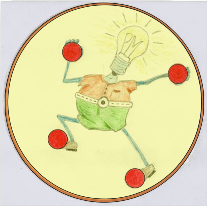
Der Durchbruch
Das Prinzip
Das Abroll-System
Das Zahnrad-System
Das Scheren-System
Das Stampfwerk
Soll ich mich schämen?
Die Software-Ratsche
autonom?
Impulsaustausch
Motus als Getriebe
Motus + Pendel
Motus + Satellit
Das Primum movens
Das Unwuchtsystem
Die Geheimnisse ..
Wenn ein Pfund ..
Das Kreuz
Der Drehpunkt
Das Kreuz im Rad
the momentous 13
my solution
the camshaft
geneva drive
... further steps
in 2022
..back to startpage

© 2021 by Alois Zimmermann | Kontakt | Impressum | Updates | Ausblick |
A mechanism for lifting the unbalanced wheel back to german
Up to now i have assumed a central gearbox to connect the unbalanced wheel to the main wheel and to keep the imbalance on one side. The realization that the 117 splices on the circumference of the merseburg wheel can also be seen as a ring gear led me to a much simpler solution: A smaller gear meshes with this ring gear and its shaft has to be slightly offset from the central shaft by a crank for this purpose. A ratchet is also installed in this crank. If this gear wheel is then on one side and is released, it rotates downward coupled with the main wheel. Before it reaches the lower dead zone, it „only” has to be pushed up in the free run in order to maintain the imbalance.
 |
This arrangement in the new ratio 7 to 6 (84 / 72 teeth) is interesting in
two respects. Firstly a structure looking similar to the so
called „motus wheel” is used to lift the inner gear and then
there is included a gear ratio of 3 to 4. To keep the gif-file small
only a quarter turn of the wheel is shown while the motus goes into
action once with a third of a turn.
The mechanism drives itself when the wheel is spinning. A fixed point is necessary like a gearbox, it is the horizontal bar in the middle. In the animation it is fixed, but it can released in the simulation and is then held in limits by two springs. In the Bessler wheel, a long stabilizing pendulum probably took over this task. Motus and ratchet practically represent a so-called „geneva drive”, which was invented many years after Besslers life. |
Somehow the verse lines in Besslers book Poëtische Apologie
page 96 fit for me:
„Wenn ich die Kunst entdeck' inwendig/”
„When I disclose the art inside/”
„ So mach' der - - euch gebändig/”
„Then the - - is catching you /”
Does he perhaps mean the cutout (- -) in the motus wheel
that is necessary for lifting the unbalanced wheel?
(An interpretation that Timo G., alias Timomathiks was the first
to bring into play).
After all, the motus wheel is pictured in the book
just below these verse lines.
Unfortunately, this mechanism is only a part of the wheel again,
the said stabilizing pendulum actually nullifies the imbalance.
You skillfully have to combine three systems to get a self-running
wheel.
In Apologische Poësie Bessler wrote on page 89:
„Ein Ding besteh't auß den drey Reichen/”
„A thing consists of the three ralms (areas, systems)/”
„Ihr habet hand=greiffliche Zeichen/”
„You have tangible signs/”
Properly combined, the three systems should stimulate each other
to build a common, overarching oscillation.
Therefore, in my opinion, the three systems are:
1. the above gear for lifting the unbalanced wheel
2. the arrangement of the flyweights on this unbalanced wheel and
3. the stampers as clock and pulse generator
The first system needs the stabilizing pendulum, but this nullifies the imbalance. The second system centrally arranged is not self-running too. Both together, with the proper offset, the two systems exchange energies and pulses with the help of the stampers and thus build up a common, interacting swinging.
Here you can find the Algodoo file to
download.
(Please note: First download the file to the download directory
and then copy it manually into the scene directory of Algodoo.
Otherwise other Algodoo files could be lost).
The simulation is set to 5 rpm.
Can you imagine that a wooden wheel can endure such a motion
sequence for a longer time even at 50 rpm?
Bessler was really good!